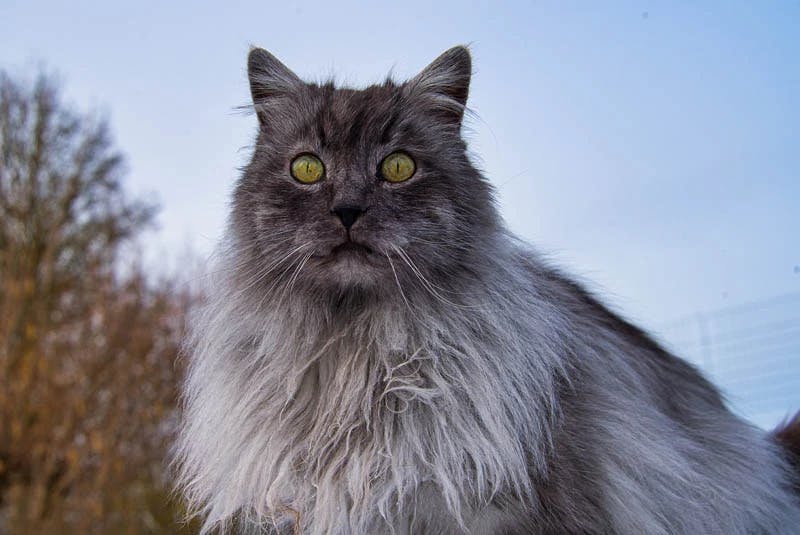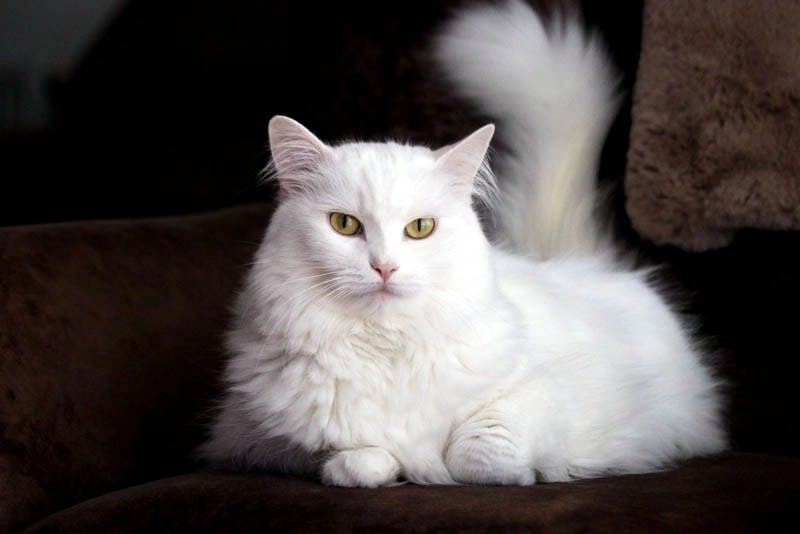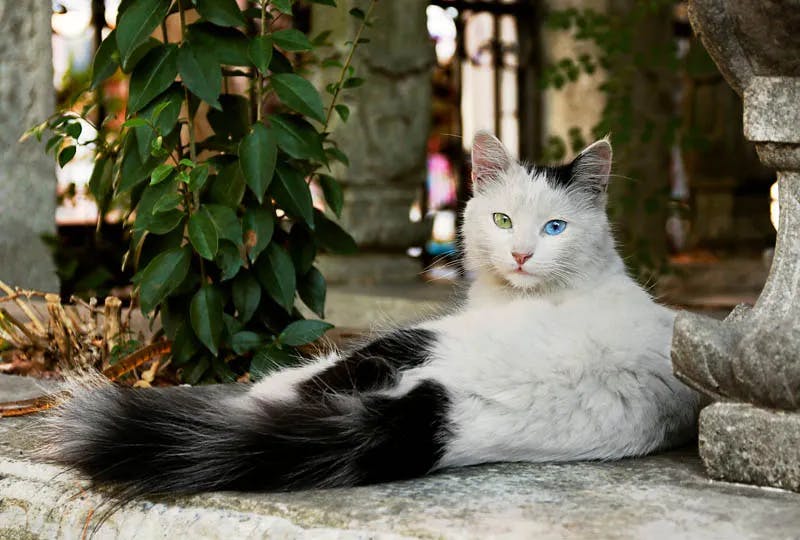Turkish Angora
A Beautiful Affectionate Cat with a Child-Friendly, Dog-Like Personality
Turkish Angora
Jon Crimes - Last Updated on December 18th, 2021
What you Need to Know about the Turkish Angora
The Turkish Angora is a cat with a beautiful personality and exquisite appearance. They are also playful, brilliant, and completely cooperative.
They are known as the ‘Turk’ by enthusiasts and Angora cat owners. This elegant and graceful cat can live in any situation. They are at home with a family of energetic children or with older people. They also seem to accept most circumstances.
Turkish Angora cats prefer to be the dominant pet in the house. They will be generally tolerant of other animals, rodents, and birds excepted, of course.

Appearance Matters. What does a Turkish Angora look like?
The Turkish Angora is most often thought of as a white cat with a long, fine, and silky coat.
Turkish Angora Colors
The breed actually comes in many different color variations.
The Black Turkish Angora is our favorite, but other Turkish Angora colors include:
- Blue
- Red
- Grey
- Cream
- Silver
They also have some very striking patterns with their coats. These include tortoiseshell, smoke, solid, bicolor, and tricolor.
Lavender, cinnamon, chocolate, or points may show crossbreeding and not purebred status.
Their small, round paws often have tufts of fur between the toes, and the tail tapers from a wide base to a narrow end.
The wedge-shaped head is small to medium in size, with large ears that sit high.
The cat's large eyes are almond-shaped with a slight upward slant.
Their eyes can be green, gold, amber, or blue. They can also have 'odd' eyes, meaning each eye has a different color.
Something to be aware of is that white cats with blue eyes can have hearing problems or even be deaf. This can also affect Turkish Angoras.
Many owners, though, have reported that their deaf cats have a unique serenity and sweetness. Probably attributed to the silence in which they live.
Because of the name, the Turkish Angora cat is often confused with the Turkish Van!
So, what is the difference between a Turkish Van and a Turkish Angora?
The Turkish Angora cat is generally a smaller and more delicate cat that can come in many colors. The Turkish Van is larger than the Angora and has a predominately white body.
If you were to see the two breeds next to each other at a show, you'd appreciate the difference straight-away.
Fully grown, the Turkish Angora can weigh up to 12 pounds and will stand up to 14 inches at the shoulder.
It's all Personal. The Turkish Angora Personality
The Turkish Angora cat personality is one of intelligence and curiosity. They love to solve problems that may be causing obstacles stopping them from getting their own way.
They also show some of the traits of dogs. This includes manifesting a desire to protect whoever it has chosen as its 'household favorite'.
Not fond of the usual, this cat is one you'll find perched up high on doors, bookcases, and furniture. They will even sit on your shoulders, enjoying the ride and the privileged view.
Clingy and affectionate, this cat will want to be near you at all times.
The Turkish Angora can also be quite domineering.
They will expect to be recognized as the 'alpha' among other pets in the home.
As with most cats, the Angora can have strong prey instincts. Take care if you have rodents.

Caring for your Turkish Angora
The Turkish Angora has a single coat, which makes grooming a lot easier than other breeds.
Groom once or twice a week with a slicker brush or fine-toothed comb. This should prevent your Turkish Angora from shedding hair and keep the hairballs down.
Turkish Angoras also love water. This is especially good news if you have a light-colored cat where they need frequent bathing.
Aside from brushing, build some other activities into your care routine. Like most cats, the Turkish Angora can be prone to periodontal disease. Practice good hygiene with your cat with daily or weekly brushing.
Cats' ears can also become dirty and infected if not cared for. Make of point of doing weekly checks of your cat's ears or whenever they are accepting a bit of petting.
If the ears are dirty, clean them with a soft, damp cloth. Avoid putting anything into their ear canals. Signs of inflammation or a 'funny' smell might need vet treatment.
Also, make sure to check their eyes for natural discharge. This can be wiped away with another soft and damp cloth.

The Health and Happiness of your Turkish Angora
Turkish Angora cats are generally quite healthy. But they can suffer from some unique breed-specific health problems.
These include:
- Hypertrophic cardiomyopathy. This heart condition is quite rare in the breed and generally affects cats between the ages of 2 and 6. Symptoms of this can be vague or non-existent. But general signs like lethargy or rapid breathing will need vet consultation. This condition is more common in males of the breed.
- Autosomal recessive disorder. Also called hereditary ataxia, this disorder causes shaking and abnormal movement in young cats. Although very rare, afflicted cats might fail to thrive and, unfortunately, might not make it to adulthood.
The Turkish Angora is also affected by genetic deafness.
This also appears in other cats, with the common factor being white cats with blue eyes.
Caused by the W gene, deafness can be difficult to detect sometimes. Affected white-haired, blue-eyed Turkish Angoras will seem to have an enviable sense of calm around them.
They will still make very suitable house pets. But owners might need to keep them as indoor animals only for their protection.
What is the Turkish Angora Lifespan?
Expect a healthy Turkish Angora to have a lifespan of between 12 and 18 years.
How Do I Find Reputable Turkish Angora Breeders?
Turkish Angora cats have a breed standard but are still somewhat rare. It might not be easy to find one, but this is where we come in to help.
Check out our list of reputable Turkish Angora breeders to find the best one for you. Their price varies a lot, but you can find one for around $600 at the lowest.
Always make sure to get your pets from good breeders who know what they are doing. This will ensure that you get the best possible pet.
Feline History. Where does the Turkish Angora come from?
So, where does the Turkish Angora originate from? The name really does say it all. Originating in the 16th century, they are considered to be a national treasure in Turkey.
Also known as the 'Ankara' or 'Turk', the breed takes its name from Ankara's previous Angora name. Maybe the first long-haired cats to be imported into Europe, the breed, however, came close to extinction and was only saved by the Ankara Zoo breeding program.
First brought to the United States in 1954, breeders instantly became intrigued by them. But enthusiasts didn't succeed in their effort to get the breed recognized by the Cat Fanciers Association until the 1960s.
The CFA registered the first Turkish Angoras in 1968. White cats got full recognition in 1972, followed by colored Turkish Angoras in 1972.
Today, most North American cat registries recognize the Turkish Angora.
